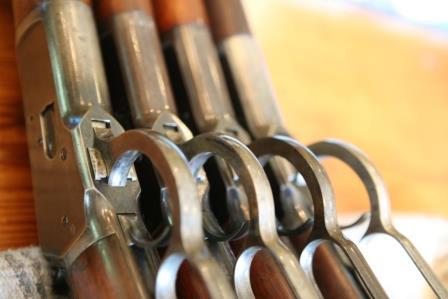February 17, 2022
 Offline
OfflineThis post sparked my curiosity. So flash light in hand I just examined my 86 TD’s. All of them except one have the witness marks. The one that doesn’t dates to 1899. The other 5 all date after 1902. The configurations vary from Deluxe rifles to ELW’s to 33 sporting rifles. Perhaps some thing happened at the turn of the century in manufacturing take downs?
March 20, 2010
 Offline
OfflineI was initially convinced as others these marks were an anomaly and didnt occur on all TD receivers and rings. However, after going trough a number of 1894 and 1892 takedowns finding they all had the indexing or alignment mark, some not being visible unless under magnification, and all appeared to fall along the center-line of the receiver/TD ring. So, Im convinced it was done at the factory, maybe as a QC to insure the proper fitting receiver, ring, and barrel / barrel & TD ring index/timing. Maybe it served for the alignment index for machining for the threaded magazine tube through the TD Ring/Receiver. I would imagine these alignment marks are more visible on some than others depending on depth and prep prior to blue. Really dont know, just my 2¢.
Chris
1892takedown @sbcglobal.net ......NRA Endowment Life Member.....WACA Member
"God is great.....beer is good.....and people are crazy"... Billy Currington
March 14, 2022
 Offline
OfflineMaybe somebody will find a factory memo or internal procedure for manufacturing/takedown assembly. Always nice to see it in stone. It’s surprising to me after all this time to be just realizing it now but, as I’ve been told by many collectors, you never stop learning when it comes to Winchesters. One of the reasons I primarily collect them!
Rick C
March 20, 2009
 Offline
Offline
Model 1892 / Model 61 Collector, Research, Valuation
March 20, 2009
 Offline
OfflineIt makes sense to me that Winchester would have placed the receiver and the takedown collars into a jig that held the side walls and marked the BDC (Bottom Dead Center) of each. Then at the point of the final manufacture of the finished rifle it would be a simple visual inspection to make certain that each component was in perfect alignment. If not the magazine would not fit into the threaded receiver face. Since these are VERY lightly inscribed on the components it might be an simple explanation as to why some rifle with wear on the bottom of the receiver does not exhibit the marks.
Michael

Model 1892 / Model 61 Collector, Research, Valuation
March 20, 2009
 Offline
Offline86Win said
My 1886 DOM 1921 has very faint marks. My 1892 DOM 1915 also has faint marks. I can just barely see them but under 10X loupe they become apparent. Both same length . One has to believe now they are factory marks.
So it doesn’t sound like you give my “takedown gnome” theory my validity??!! 


Model 1892 / Model 61 Collector, Research, Valuation
December 21, 2006
 Offline
OfflineSpeaking of takedowns, do We know when the transition was made on the mod. ’94 takedown lever,(crank), from being at the 12:00 position with an inletted barrel to lockit, to the Crank being at the 11:oo o’clock position with out the inletted barrel lock. It has to be somewhere between ser#63117, (1899) and ser#134685,(1901), Then I have ser#139724 with the 12:0’clock locked position crankand everything after with the 11:00 o’clock position crank. I don’t recall seeing this information any where, but then My recall is not as sharp as it once was.
W.A.C.A. life member, Marlin Collectors Assn. charter and life member, C,S.S.A. member and general gun nut.
June 26, 2013
 Offline
OfflineRick C said
Thank you to all who have checked and posted. The alignment marks are “obviously” factory. Found on 86’s/92’s/94’s so far. It would be interesting now to know the earliest dom and model.
Also on model 53’s and 55’s as stated by other members on this thread. Doesn’t that cover all the takedown models (minus the 1873’s) with tubular magazines?
Don


 Log In
Log In











